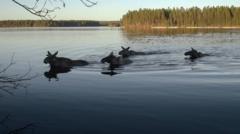Every spring, a unique spectacle unfolds in northern Sweden as millions of viewers flock to a livestream tracking the Great Moose Migration. This year's round-the-clock broadcast kicked off on Tuesday, a week earlier than planned due to an unseasonably warm April. The livestream, hosted by SVT Play, provides an intimate look at the elk as they traverse the Angerman River in search of summer pastures, a tradition that has captured the hearts of audiences since 2019.
Cait Borjesson, a 60-year-old viewer who discovered the stream during the Covid-19 pandemic, shares her experience of watching the elk journey for hours on end. "It's unbelievably relaxing," she expressed, highlighting the calming effect of the natural sounds captured in the broadcast. This pastime has grown into a yearly ritual, prompting her to take time off work to enjoy the streaming event fully.
The livestream has not only provided solace to viewers but has also created a community, with over 77,000 members in a dedicated Facebook group sharing their experiences and insights about the migration. Much of the action unfolds near the village of Kullberg, where these majestic animals, known as moose in North America and elk in Europe, begin their long trek after spending the winter aggregated in warmer locations.
Goran Ericsson, an expert in forest sciences at the Swedish University of Agricultural Sciences, noted that approximately 95% of the region's elk migrate annually and that early migrations are not unusual with climate variations. The increase in viewer engagement has been staggering, with nearly a million tuning in for the inaugural stream in 2019 and growth to nine million by 2024.
Minh-Xuan Truong, a researcher, explained that the audience's preference for the "slow TV" format speaks volumes in our fast-paced media world. Many viewers appreciate the raw sounds of nature, opting to listen to the background of wind, birds, and trees rather than added music or commentary. With Sweden hosting approximately 300,000 elk, known as the "King of the Forest," the migration continues to be a captivating event for both viewers and wildlife enthusiasts alike.























